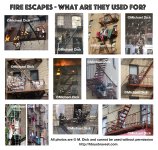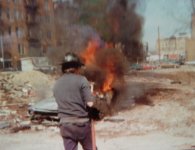- Joined
- Aug 25, 2009
- Messages
- 28,585
Thank you Dan
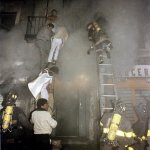
Meet anyone famous on BI Dan....... I feel like that would be a cool topicAlways hated BI, did a lotta Harlem shuckin' & jivin' during those 3 hr. stints, but ALWAYS made sure we checked out the condition of tenement fire escapes. Goose neck secure! Treads rusted, loose or missing, etc! Don't overcrowd FE! Always remembered a tip from old timer, when descending FE, go down facing the steps in case tread breaks or is missing (fall into FE rather than off)
Butterfly McQueen (Gone With the Wind) lived in Brownstone in our 1st due response area, but never did meet nor see her. Should ask JohnnyG, I'm sure he met a few "famous" people in the days he was hobnobbing down in Greenwich Village (L5)!!!Meet anyone famous on BI Dan....... I feel like that would be a cool topic
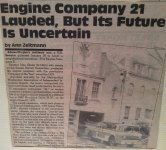
Woody Harrelson used to be a regular, he'd come in late at night from a bender and hang o
But meeting Mr. Willy was by far the best!
View attachment 28131
FIRE ESCAPES
(Summer 1983). Another hot, sweltering sticky day in the Bronx, hydrants run full blast as the odor of decaying garbage mixed with hot tar fumes from the street permeates the soupy air. Engine 88 has been assigned to the second alarm for a vacant tenement fire at Jerome Avenue near Fordham Road. I’m behind the wheel for the day and in the process of hooking up to a hydrant on Jerome Avenue under the elevated train rumbling overhead. Focused on opening the hydrant to flush, my handy-talkie radio bursts aloud with an excited command; “MAN DOWN, WE NEED EMS FORTHWITH”. Usually a Mayday radio transmission but there is no need for the Mayday to garner attention from the command post, a member has plummet from the fire escape directly in front onto the sidewalk.
The member is E 88 Probationary Firefighter Mike who was operating on the front fire escape second floor landing and unwittingly stepped backwards through the drop ladder opening, and crashed to the sidewalk below.
In New York City fire escapes are archetypal of the city’s landscape. New Yorkers have been using fire escapes to sit outside, hang clothes to dry, storage space for bicycles, growing potted plants and more. After many horrific fatal fires in tenements and especially the Triangle Shirtwaist Factory fire during the 1800’s, NYC required wrought iron fire escapes to be properly affixed to tenements.
Over time, fire escapes exposed to weather for over 100 years have weakened and rust. Attached to buildings with bolts, the rust eats through components and can cause failure when weight or an impact load is placed on a stair tread, weld piece or landing.
The FDNY relies on the useful advantages of fire escapes and employs them within various procedures. Engine companies can use fire escapes to stretch additional handlines, the Outside Vent firefighter will use the fire escape as a platform to perform vent entry and search, and the Roof firefighter may use the fire escape as a last resort to gain access to the roof.
Random thoughts:
- When lowering the drop ladder with a hook, stand beneath the fire escape, should the drop ladder become detached from the track it will fall away instead of on top of you, but make sure that area is clear as well. (Be aware, corrosion or paint may prevent the ladder from sliding down the track).
- When climbing the drop ladder; ensure you maintain a constant grip on the rails of the ladder and climb slowly and deliberately. Place the hook high on the ladder, no need to carry.
- Climb fire escape steps with feet closer to the edge of the step stringer and not in the weaker middle part of the tread.
- Firefighters should be forewarned coming upon broken steps for other defected features.
- Members MUST be familiarized with self contained breathing apparatus “reduced profile” maneuver. Many fire escapes are extremely narrow and actuating a reduced profile will be your only option to pass through.
- Do not lean against any railing.
- Before climbing the gooseneck ladder to the roof which is usually located in the rear of the structure, the firefighter should vigorously tug it from the wall to ascertain stability and climb sliding hands along the beam for continuous contact.
Laddering fire escapes:
- Place a portable ladder alongside the fire escape on the structure. Ladder should extend 1-3 feet above the fire escape railing.
- Never place the weight of an aerial ladder onto the fire escape.
Rescuing People from overcrowded Fire Escape:
- Place a portable ladder opposite the drop ladder to alleviate overcrowding on the second floor landing.
- If an additional ladder is needed, place ladder to the second balcony above the drop ladder against structure 1-3 feet above railing.
- (TIP) If necessary to control uncooperating tenants evacuating, consider climbing inside the drop ladder, swing around to access the second floor landing.
Operating on and around fire escapes is a paramount concern for firefighter safety, there are numerous instances where firefighters have been severely injured, even when they were very careful. Fire escapes are an accident waiting to happen.
Thankfully Mike returned to work and became a stellar member of L 38 and completed a super career.
Photo by Mike Dick, from "Into the Smoke with NYs Bravest". Thanks Mike.
View attachment 28081
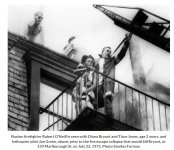
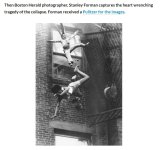
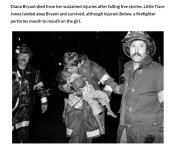
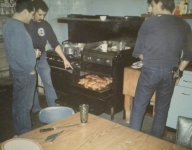
FIRE ESCAPES
(Summer 1983). Another hot, sweltering sticky day in the Bronx, hydrants run full blast as the odor of decaying garbage mixed with hot tar fumes from the street permeates the soupy air. Engine 88 has been assigned to the second alarm for a vacant tenement fire at Jerome Avenue near Fordham Road. I’m behind the wheel for the day and in the process of hooking up to a hydrant on Jerome Avenue under the elevated train rumbling overhead. Focused on opening the hydrant to flush, my handy-talkie radio bursts aloud with an excited command; “MAN DOWN, WE NEED EMS FORTHWITH”. Usually a Mayday radio transmission but there is no need for the Mayday to garner attention from the command post, a member has plummet from the fire escape directly in front onto the sidewalk.
The member is E 88 Probationary Firefighter Mike who was operating on the front fire escape second floor landing and unwittingly stepped backwards through the drop ladder opening, and crashed to the sidewalk below.
In New York City fire escapes are archetypal of the city’s landscape. New Yorkers have been using fire escapes to sit outside, hang clothes to dry, storage space for bicycles, growing potted plants and more. After many horrific fatal fires in tenements and especially the Triangle Shirtwaist Factory fire during the 1800’s, NYC required wrought iron fire escapes to be properly affixed to tenements.
Over time, fire escapes exposed to weather for over 100 years have weakened and rust. Attached to buildings with bolts, the rust eats through components and can cause failure when weight or an impact load is placed on a stair tread, weld piece or landing.
The FDNY relies on the useful advantages of fire escapes and employs them within various procedures. Engine companies can use fire escapes to stretch additional handlines, the Outside Vent firefighter will use the fire escape as a platform to perform vent entry and search, and the Roof firefighter may use the fire escape as a last resort to gain access to the roof.
Random thoughts:
- When lowering the drop ladder with a hook, stand beneath the fire escape, should the drop ladder become detached from the track it will fall away instead of on top of you, but make sure that area is clear as well. (Be aware, corrosion or paint may prevent the ladder from sliding down the track).
- When climbing the drop ladder; ensure you maintain a constant grip on the rails of the ladder and climb slowly and deliberately. Place the hook high on the ladder, no need to carry.
- Climb fire escape steps with feet closer to the edge of the step stringer and not in the weaker middle part of the tread.
- Firefighters should be forewarned coming upon broken steps for other defected features.
- Members MUST be familiarized with self contained breathing apparatus “reduced profile” maneuver. Many fire escapes are extremely narrow and actuating a reduced profile will be your only option to pass through.
- Do not lean against any railing.
- Before climbing the gooseneck ladder to the roof which is usually located in the rear of the structure, the firefighter should vigorously tug it from the wall to ascertain stability and climb sliding hands along the beam for continuous contact.
Laddering fire escapes:
- Place a portable ladder alongside the fire escape on the structure. Ladder should extend 1-3 feet above the fire escape railing.
- Never place the weight of an aerial ladder onto the fire escape.
Rescuing People from overcrowded Fire Escape:
- Place a portable ladder opposite the drop ladder to alleviate overcrowding on the second floor landing.
- If an additional ladder is needed, place ladder to the second balcony above the drop ladder against structure 1-3 feet above railing.
- (TIP) If necessary to control uncooperating tenants evacuating, consider climbing inside the drop ladder, swing around to access the second floor landing.
Operating on and around fire escapes is a paramount concern for firefighter safety, there are numerous instances where firefighters have been severely injured, even when they were very careful. Fire escapes are an accident waiting to happen.
Thankfully Mike returned to work and became a stellar member of L 38 and completed a super career.
Photo by Mike Dick, from "Into the Smoke with NYs Bravest". Thanks Mike.
View attachment 28081
